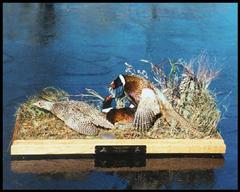Pheasant - Ringneck
Common Pheasant, Chinese Ringneck Pheasant, True Pheasant Scientific Name: Phasianus colchicus
Sat, 5th October, 2024 - 11:16 am GMT
Sponsor Ads:

Alternative Name
Common Pheasant, Chinese Ringneck Pheasant, True Pheasant Scientific Name: Phasianus colchicusBasic Info
The Ringneck Pheasant is easily identifiable by the presence of a white ring around its neck. What many people may not know is that only the male has this marking. Females lack the white ring from which this species gets its name. There are over 20 different subspecies of Ringneck pheasant and they all bear a slightly different appearance. Because the males and females are sexually dimorphic they will be described separately. Aside from the missing white ring the females are generally smaller than males, measuring an average 25 inches at maturity. Females also have duller coloration than males. Their plumage is buff colored with black and brown speckles. Females will usually attain their adult coloration by 1 year of age. Males have striking red wattles and their face is also a bright red color. The males also have feathers, which stick out at the base of the crown, these feathers are often said to look like small horns. The male's tail is also longer than the female's and it has black stripes across it. The male will grow to an average length of 35 inches at maturity. In addition to regional differences, because this species has been bred in captivity for so long there are several different color and size variations such as the Green or Black Mutant and the Jumbo variety. Other ornamental colors are becoming more and more common and these include white, buff, cinnamon, platinum, pied, red and chocolate.
Health
Adult pheasants should be given 5.5 pounds of feed daily. If breeding, females should be given higher quality feed in higher amounts. Pheasants may be housed in coups when they are young, but adults tend to do better in flyways. If weather conditions are harsh they should be provided shelter. Flyways should be built to protect pheasants from predators such as raptors, minks and raccoons. The Ringneck Pheasant is a hearty bird, though like other pheasants they are susceptible to Coccidiosis and this is the most common disease seen among Ringnecks. In some areas permits are required to keep Ringnecks, it is important to check with the local authorities before purchasing these birds. Breeding The Ringneck Pheasant is a prolific breeder and is bred regularly in captivity. Females reach sexual maturity around 12 months of age and at this time they will mate with a male. Males will mate with several females during each breeding season. Like other pheasants, Ringnecks are seasonal breeders and do not form monogamous pairs. Breeding season will typically begin in March and it usually begins with courting displays from the males. Because males will breed several females, it is a good idea to keep them at a ratio of 1 male per every 10 females, especially if they are kept in confinement. If more males are housed together they will usually fight for dominance. After breeding the female will lay anywhere from 8 to 15 eggs on average. Egg laying usually begins in April and lasts until June. In one year the Ringneck Pheasant will lay between 40 and 90 eggs. The incubation period is 24 days. Eggs should be collected daily to help ensure fertile eggs. If the female is allowed to incubate on the nest, the number of fertile eggs may decrease. Ringneck females do brood well, but commercially people usually chose to incubate over allowing females to incubate due to high levels of egg loss. Incubators also help to decrease disease transmission. It should also be noted that Ringneck chicks often become very aggressive towards each other during brooding, and they may even kill and eat each other. This can be avoided if plenty of room is provided in the brooding area.Habitat
The Ringneck Pheasant is usually found in open areas such as grass and cornfields.Behavior
The Ringneck Pheasant may well be the best known of all pheasants. Though they are a popular game bird in North America, this species is actually native to China, and was imported to North America in the late 1800s. They are also seen along old railroad tracks and creek beds. This species adapts well to a domestic environment, in part because it does spend much of its life on the ground.Origin
ChinaHistory
The Ringneck Pheasant is known by several different common names, which include Common Pheasant, Chinese Ringneck Pheasant, and True Pheasant. The Ringneck Pheasant was first imported from China to Oregon in 1881. The Ringneck has continued to flourish since that time and has become very popular in the United States, where it is now seen in almost every state. Because they are so common in the wild, many people believe they are native to North America. The Ringneck has also been imported to Australia, New Zealand, Japan, and Western Europe. There are even hunting seasons in many parts of the world both for sport, and to control population. Historically Rinknecks have been raised domestically for meat and more recently they have been bred for feather production and ornamental purposes.Common Foods
They usually feed on insects and grains and the ground, and these are usually plentiful in fieldsSponsor Ads:
When you adopt a tool you adopt the management philosophy embedded in that tool. -- Clay Shirky (Ted Talk - How the Internet will (one day) transform government)
Pheasant - Ringneck
Coded by: BGID® | ALL RIGHTS RESERVED Copyright © 2000-2024
Disclaimer | Privacy | Report Errors / Contact | Credits
















